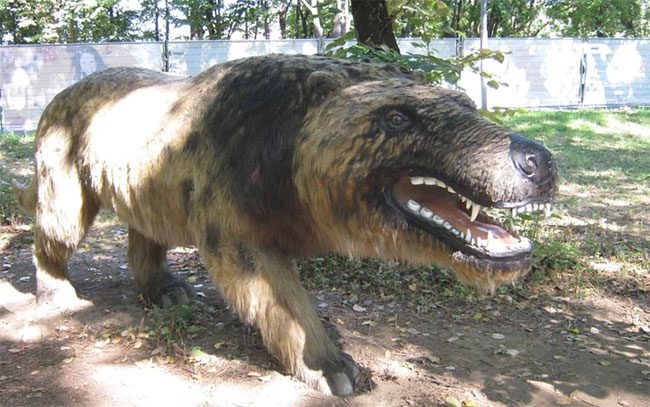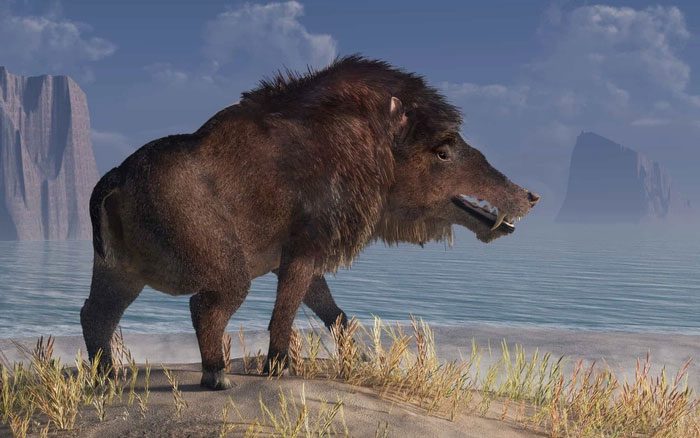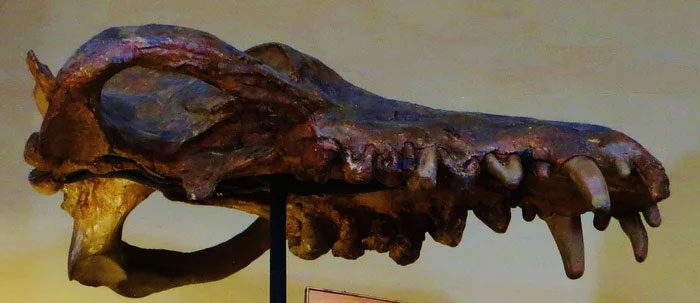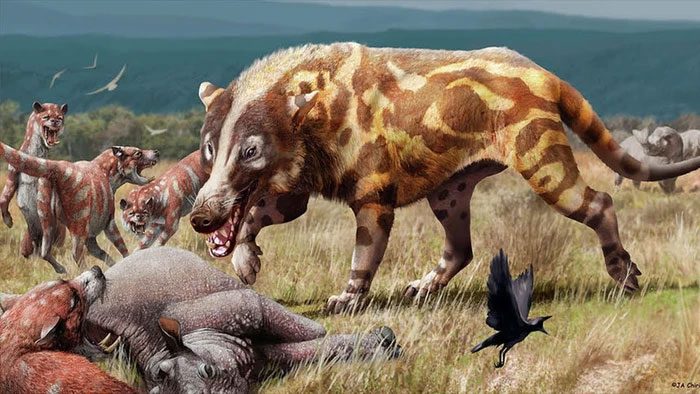Today, Andrewsarchus is known only through the remaining fossil evidence. Research indicates that Andrewsarchus stood as tall as a horse and weighed over a ton. This size makes it one of the largest carnivorous mammals to have ever roamed the Earth.

Andrewsarchus stood as tall as a horse and weighed over a ton.
Throughout Earth’s history, numerous animal species have called this blue planet home. Some of today’s carnivores are significantly larger than humans. Notably, bears, tigers, and various big cats are among the largest terrestrial predators on the planet.
One of the oldest predatory animals to have existed on Earth is Andrewsarchus. At the same time, they are considered the largest terrestrial carnivorous mammals ever to exist.
Thanks to the fossils left behind by this creature, paleontologists have studied them and uncovered amazing facts about this giant predator that lived millions of years ago.

Andrewsarchus is a genus of mammals that lived during the middle Eocene in what is now Inner Mongolia, China. The only recognized species is A. mongoliensis, known from a skull discovered in 1923 during an AMNH expedition. Initially classified as a Mesonychia, more recent studies suggest it is an even-toed ungulate, more accurately a member of the Cetacodontamorpha branch, closely related to Entelodontidae, hippos, and whales.
Andrewsarchus is an extinct genus of carnivorous mammals that lived during the Eocene epoch. Andrewsarchus mongoliensis is the sole species in this genus. This creature was a mammal, and recent studies classify it as an artiodactyl – a member of the even-toed ungulates. It belongs to the Cetancodontamorpha branch, closely related to animals such as hippos, dolphins, and whales.
Currently, Andrewsarchus is only known from a single fossil, discovered in the spring of 1923. During an expedition led by paleontologist Roy Chapman Andrews, a large skull measuring 3 feet long was found by expedition member Kan Chuen Pao.
The American Museum of Natural History in New York sponsored the expedition. The name Andrewsarchus mongoliensis was given in honor of the expedition leader and the location where the fossil was found – Inner Mongolia.
Upon its discovery, expedition members believed the large skull of Andrewsarchus belonged to an extinct species of pig. After further study, paleontologists determined that this fossil belonged to a new species.
When first classified, Andrewsarchus was placed in the mesonychid category and was referred to as a “giant mesonychid of Mongolia.”
Today, through more specialized studies, Andrewsarchus is classified as an artiodactyl.

One remarkable aspect of Andrewsarchus is that it lived at a time when mammals were beginning to achieve gigantic sizes – the Eocene epoch, approximately 45 to 35 million years ago. The gigantic size of this carnivorous animal indicates that mammals matured much faster than before.
The skull of Andrewsarchus is the only known fossil and measures about 2.8 feet (86 cm) long and 1.8 feet (56 cm) wide. Its mouth was filled with large, sharp teeth. Using similar fossils, experts can estimate the size of this creature. It is estimated that Andrewsarchus was roughly the size of a modern zebra.
While the exact appearance of this large mammal remains unknown, most descriptions suggest it resembled shaggy pigs.
Debates have arisen in the paleontology community about what this animal may have eaten. The most widely accepted hypothesis is that it was indeed a carnivorous species. Experts believe Andrewsarchus was both a scavenger and a predator. With its gigantic size, Andrewsarchus could have been an apex predator capable of taking down most animals it attacked.

Andrewsarchus mongoliensis had 3 incisors, 1 canine, 4 small molars, and 3 molars on each side of its jaw. The incisors were arranged in a semicircle, the second and third molars elongated and growing separately, while the first and second molars were more worn down than the preceding and following teeth.
Andrewsarchus was a mammal that lived about 48 to 41 million years ago during the middle Eocene. It was first discovered by Kan Chuen Pao in Mongolia in 1923. It was later described and named by Henry Fairfield Osborn in 1924. One of the most fascinating facts about Andrewsarchus is that it is known only from a single skull. This skull, which closely resembles that of a wolf, possesses all the essential features to identify this animal as a mammal. Another fact about Andrewsarchus – a fact based on scientific observation – is that this carnivorous animal had an extremely powerful jaw. However, scientists currently do not know how strong its bite might have been. Since its discovery, it has been hypothesized that this animal may have used its strong jaws to crush turtle shells and other hard-shelled animals. |


















































